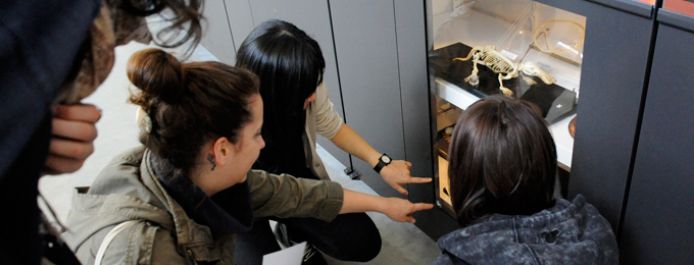| Small group (1-15 participants) | $ 150 |
| Large group (16-30 participants) | $250 |
* Please see booking information for more details.
Explore the museum’s six collections at your own pace and with your own focus. Our collections include fungi, moss, plants, marine invertebrates, mammals, birds, reptiles, fishes, insects, and more! Teachers and other group leaders are welcome to design and lead their own lessons or to take advantage of the museum’s ongoing and featured activities. Learn about the current exhibitions on display for your visit, and find answers to some common accessibility questions.
This type of visit is appropriate for all grades and most group sizes. Self-led visits are available throughout the year on any day the museum is open.

Targeted Curriculum
- Kindergarten: Plants and animals have observable features, daily and seasonal changes affect all living things
- Science 1: Living things have features and behaviours that help them survive in their environment
- Science 2: All things have a life cycle; water is essential to all living things and it cycles through the environment
- Science 3: Living things are diverse, can be grouped, and interact in their ecosystems
- Science 4: All living things and their environment are interdependent
- Science 5: Multicellular organisms have organ systems that enable them to survive and interact within their environment; humans use earth materials as natural resources
- Science 6: Multicellular organisms rely on internal systems to survive, reproduce, and interact with their environment
- Science 7: The theory of evolution by natural selection provides an explanation for the diversity and survival of living things; Earth and its climate have changed over geological time
- Science 8: The theory of plate tectonics is the unifying theory that explains Earth’s geological processes; cells are a basic unit of life
- Science 9: The biosphere, geosphere, hydrosphere, and atmosphere are interconnected, as matter cycles and energy flows through them; cells are derived from cells
- Science 10: Genes are the foundation for the diversity of living things
- Biology 11: All organisms have characteristics that define them as living and interdependent. Life can be organized in a functional and structural hierarchy ranging from cells to the biosphere; living things are interdependent; living things are diverse and evolve over time
- Biology 12: Cells are the basic unit of life
We encourage you to visit the museum before your class or group does, and look deeper into the collections for cross-curricular inspiration, including mathematics, English language arts, social studies, arts education, and science.
Use our calendar to help select programming to fit your day.
Resources
We have a wide variety of educator resources to support you before, during, and after your visit. Here are some suggested ways to frame your exploration:
Before your visit:
- Get to know our space, enjoy an audio tour or 360° virtual tour of the museum, using our online visitor guide (html) or printable visitor guide (pdf) to help navigate the museum.
- Explore our museum terminology sheet and Researchers Revealed site
- Check out our Current Exhibitions and online exhibit 100 Years, 100 Treasures
At the museum:
- We suggest using a scavenger hunt or other activity to help students explore the museum in a guided way. Click the links for Scavenger Hunts and Museum Activities and Raising Big Blue worksheet
- Look for Culture at the Centre and the Sturgeon Knowledge Web exhibits sharing First Peoples’ knowledge and perspectives on biodiversity.
After your visit:
-
- Create a Nature Table in your classroom
- Learn more about Extending the Field Trip
- Reflect on the blue whale using these Raising Big Blue writing prompts
- Continue Describing and Drawing Organisms in your own backyard
- Click here to view and download a PDF version of our visitor guide. Hard copies of the visitor guide are available at the front desk for your visit.
Accessibility Notes
We will move around the museum which is equipped with level concrete flooring and ramps. There are no lips or steps to get to all program areas. Some spaces in the museum are dark and/or narrow, but can fit a wheelchair easily. Expect to spend some time walking, standing, and sitting. Students may work in pairs, small groups, or as a large group. Activities may incorporate drawing or writing, touching real museum specimens, and discussions. Read more about accessibility in the museum here. We will ensure we get all group members to participate in a way that works for them. Let us know how we can meet the access needs of your group!
